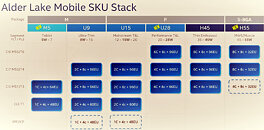Intel is expected to announce their desktop Alder Lake processors later this month on October 28th and it would appear that laptop processors could enter production as early as November. These revelations come from a leaked roadmap published by Wccftech that lists the Alder Lake-P and Alder Lake-M processor families for launch in Q4 2021 and Q1 2022 respectively. The production window for Alder Lake-P opens November 8th and closes March 13th while for Alder Lake-M that period is from January 17th to April 17th.
The roadmap lists Alder Lake-P processors as featuring a TDP between 12 W to 45 W and Alder Lake-M covering 7 W to 15 W. The two platforms will both feature up to 96 Xe graphics Execution units along with Thunderbolt 4 and WiFi 6E connectivity. Alder Lake-P will include PCIe 5.0 and DDR5 support with no mention of DDR4 compatibility while Alder Lake-M will get PCIe 4.0 and LPDDR4X/LPDDR5. The mobile lineup is divided into 3 groups of which the flagship H55 was not mentioned in the roadmap indicating a post Q1 2022 release.


The Alder Lake-M lineup will feature tablet and ultra-thin processors with core counts between 5 and 10 paired with 48 to 96 Xe Execution Units. The Alder Lake-P series will have products for mainstream, performance, and enthusiast devices with core counts ranging from 6 to 14 and 80 to 96 Xe Execution Units. The final H55 segment processors will feature 16 cores evenly split between high-efficiency and high-performance along with 32 Execution Units.
View at TechPowerUp Main Site
The roadmap lists Alder Lake-P processors as featuring a TDP between 12 W to 45 W and Alder Lake-M covering 7 W to 15 W. The two platforms will both feature up to 96 Xe graphics Execution units along with Thunderbolt 4 and WiFi 6E connectivity. Alder Lake-P will include PCIe 5.0 and DDR5 support with no mention of DDR4 compatibility while Alder Lake-M will get PCIe 4.0 and LPDDR4X/LPDDR5. The mobile lineup is divided into 3 groups of which the flagship H55 was not mentioned in the roadmap indicating a post Q1 2022 release.


The Alder Lake-M lineup will feature tablet and ultra-thin processors with core counts between 5 and 10 paired with 48 to 96 Xe Execution Units. The Alder Lake-P series will have products for mainstream, performance, and enthusiast devices with core counts ranging from 6 to 14 and 80 to 96 Xe Execution Units. The final H55 segment processors will feature 16 cores evenly split between high-efficiency and high-performance along with 32 Execution Units.
View at TechPowerUp Main Site



